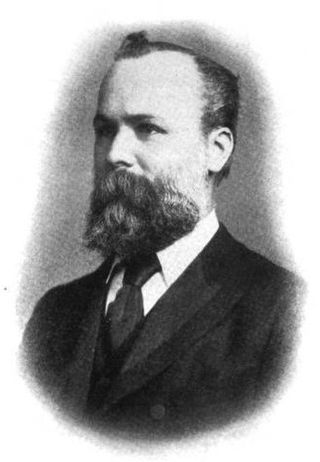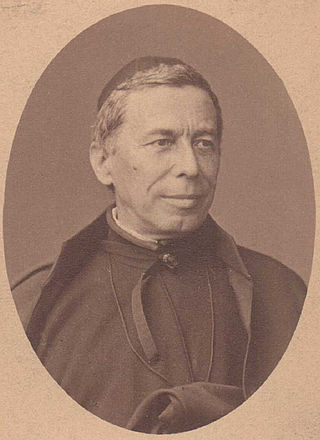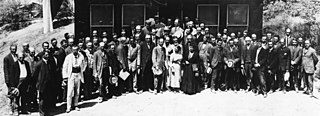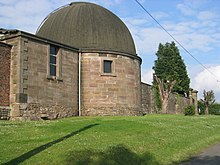
The ecliptic or ecliptic plane is the orbital plane of Earth around the Sun. From the perspective of an observer on Earth, the Sun's movement around the celestial sphere over the course of a year traces out a path along the ecliptic against the background of stars. The ecliptic is an important reference plane and is the basis of the ecliptic coordinate system.

Longitude is a geographic coordinate that specifies the east–west position of a point on the surface of the Earth, or another celestial body. It is an angular measurement, usually expressed in degrees and denoted by the Greek letter lambda (λ). Meridians are imaginary semicircular lines running from pole to pole that connect points with the same longitude. The prime meridian defines 0° longitude; by convention the International Reference Meridian for the Earth passes near the Royal Observatory in Greenwich, south-east London on the island of Great Britain. Positive longitudes are east of the prime meridian, and negative ones are west.

A prime meridian is an arbitrary meridian in a geographic coordinate system at which longitude is defined to be 0°. Together, a prime meridian and its anti-meridian form a great circle. This great circle divides a spheroid, like Earth, into two hemispheres: the Eastern Hemisphere and the Western Hemisphere. For Earth's prime meridian, various conventions have been used or advocated in different regions throughout history. Earth's current international standard prime meridian is the IERS Reference Meridian. It is derived, but differs slightly, from the Greenwich Meridian, the previous standard.

The Mount Wilson Observatory (MWO) is an astronomical observatory in Los Angeles County, California, United States. The MWO is located on Mount Wilson, a 1,740-meter (5,710-foot) peak in the San Gabriel Mountains near Pasadena, northeast of Los Angeles.

Edward Walter Maunder was an English astronomer. His study of sunspots and the solar magnetic cycle led to his identification of the period from 1645 to 1715 that is now known as the Maunder Minimum.
The National Solar Observatory (NSO) is a United States federally funded research and development center to advance the knowledge of the physics of the Sun. NSO studies the Sun both as an astronomical object and as the dominant external influence on Earth. NSO is headquartered in Boulder and operates facilities at a number of locations - at the 4-meter Daniel K. Inouye Solar Telescope in the Haleakala Observatory on the island of Maui, at Sacramento Peak near Sunspot in New Mexico, and six sites around the world for the Global Oscillations Network Group one of which is shared with the Synoptic Optical Long-term Investigations of the Sun.
Richard Christopher Carrington was an English amateur astronomer whose 1859 astronomical observations demonstrated the existence of solar flares as well as suggesting their electrical influence upon the Earth and its aurorae; and whose 1863 records of sunspot observations revealed the differential rotation of the Sun.

Angelo Secchi was an Italian Catholic priest, astronomer from the Italian region of Emilia. He was director of the observatory at the Pontifical Gregorian University for 28 years. He was a pioneer in astronomical spectroscopy, and was one of the first scientists to state authoritatively that the Sun is a star.

Solar rotation varies with latitude. The Sun is not a solid body, but is composed of a gaseous plasma. Different latitudes rotate at different periods. The source of this differential rotation is an area of current research in solar astronomy. The rate of surface rotation is observed to be the fastest at the equator and to decrease as latitude increases. The solar rotation period is 24.47 days at the equator and almost 38 days at the poles. The average rotation is 28 days.
Solar physics is the branch of astrophysics that specializes in the study of the Sun. It deals with detailed measurements that are possible only for our closest star. It intersects with many disciplines of pure physics, astrophysics, and computer science, including fluid dynamics, plasma physics including magnetohydrodynamics, seismology, particle physics, atomic physics, nuclear physics, stellar evolution, space physics, spectroscopy, radiative transfer, applied optics, signal processing, computer vision, computational physics, stellar physics and solar astronomy.

A solar telescope is a special purpose telescope used to observe the Sun. Solar telescopes usually detect light with wavelengths in, or not far outside, the visible spectrum. Obsolete names for Sun telescopes include heliograph and photoheliograph.

Annie Scott Dill Maunder was an Irish-British astronomer, who recorded the first evidence of the movement of sunspot emergence from the poles toward the equator over the sun's 11-year cycle. She was one of the leading astronomers of her time, but because of her gender, her contribution was often underplayed at the time. In 1916 she was elected to the Royal Astronomical Society, 21 years after being refused membership because of her gender.

The Toronto Magnetic and Meteorological Observatory is a historical observatory located on the grounds of the University of Toronto, in Toronto, Ontario, Canada. The original building was constructed in 1840 as part of a worldwide research project run by Edward Sabine to determine the cause of fluctuations in magnetic declination. Measurements from the Toronto site demonstrated that sunspots were responsible for this effect on Earth's magnetic field. When this project concluded in 1853, the observatory was greatly expanded by the Canadian government and served as the country's primary meteorological station and official timekeeper for over fifty years. The observatory is considered the birthplace of Canadian astronomy.

Stephen Joseph Perry SJ FRS was an English Jesuit and astronomer, known as a participant in scientific expeditions.
A Stonyhurst disk is a transparent circular grid with lines of longitude and latitude that can overlay a solar image to reference the positions of sunspots. This overlay system was originally created at the Stonyhurst College observatory.

The Gauribidanur Radio Observatory is a radio telescope observatory located at Gauribidanur, near Bengaluru. It is operated jointly by Raman Research Institute and the Indian Institute of Astrophysics. The observatory has been in operation since 1976.
This glossary of astronomy is a list of definitions of terms and concepts relevant to astronomy and cosmology, their sub-disciplines, and related fields. Astronomy is concerned with the study of celestial objects and phenomena that originate outside the atmosphere of Earth. The field of astronomy features an extensive vocabulary and a significant amount of jargon.

Aloysius Laurence Cortie was an English Jesuit astronomer. He served as director of the Stonyhurst College Observatory and contributed to the study of the Sun, including through observing solar eclipses.
Solar observation is the scientific endeavor of studying the Sun and its behavior and relation to the Earth and the remainder of the Solar System. Deliberate solar observation began thousands of years ago. That initial era of direct observation gave way to telescopes in the 1600s followed by satellites in the twentieth century.

Solar phenomena are natural phenomena which occur within the atmosphere of the Sun. These phenomena take many forms, including solar wind, radio wave flux, solar flares, coronal mass ejections, coronal heating and sunspots.




















